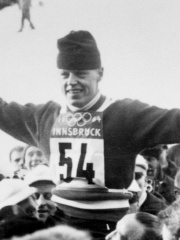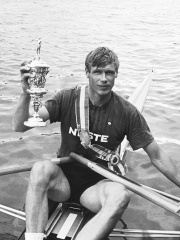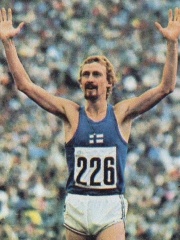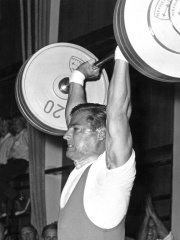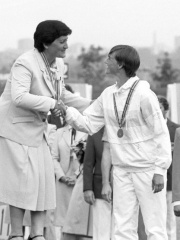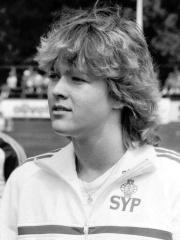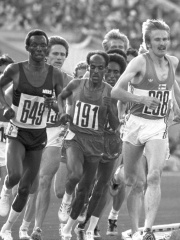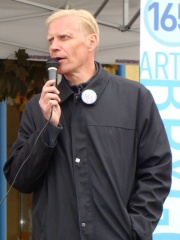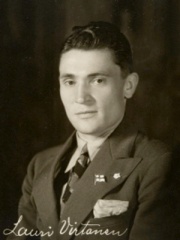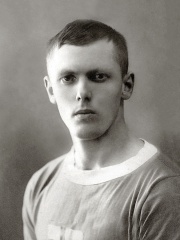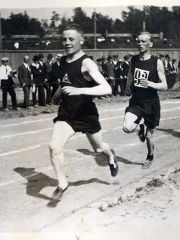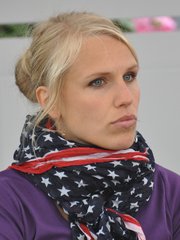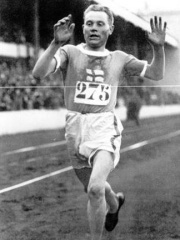
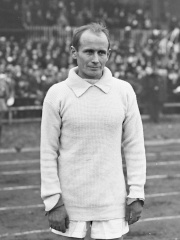
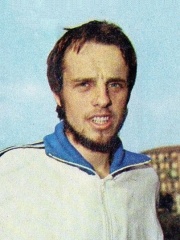
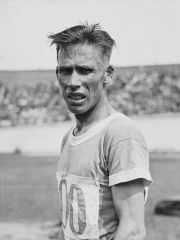
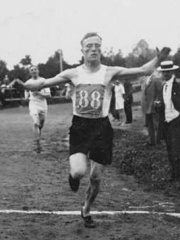
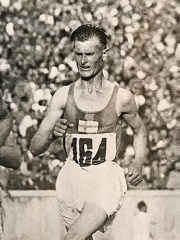
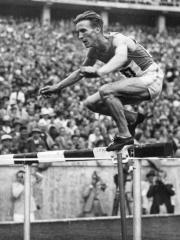
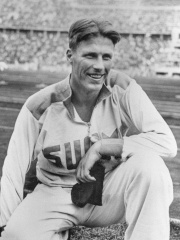
The Most Famous
ATHLETES from Finland
This page contains a list of the greatest Finnish Athletes. The pantheon dataset contains 6,025 Athletes, 168 of which were born in Finland. This makes Finland the birth place of the 22nd most number of Athletes behind New Zealand, and Czechia.
Top 10
The following people are considered by Pantheon to be the top 10 most legendary Finnish Athletes of all time. This list of famous Finnish Athletes is sorted by HPI (Historical Popularity Index), a metric that aggregates information on a biography's online popularity. Visit the rankings page to view the entire list of Finnish Athletes.

1. Paavo Nurmi (1897 - 1973)
With an HPI of 75.77, Paavo Nurmi is the most famous Finnish Athlete. His biography has been translated into 65 different languages on wikipedia.
Paavo Johannes Nurmi (Finnish pronunciation: [ˈpɑːʋo ˈnurmi] ; 13 June 1897 – 2 October 1973) was a Finnish middle-distance and long-distance runner. He was called the "Flying Finn" because he dominated distance running in the 1920s. Nurmi set 22 official world records at distances between 1,500 metres and 20 kilometres, and won nine gold and three silver medals in his 12 events in the Summer Olympic Games. At his peak, Nurmi was undefeated for 121 races at distances from 800 m upwards. Throughout his 14-year career, he remained unbeaten in cross country events and the 10,000 metres. Born into a working-class family, Nurmi left school at the age of 12 to provide for his family. In 1912, he was inspired by the Olympic feats of Hannes Kolehmainen and began developing a strict training program. Nurmi started to flourish during his military service, setting Finnish records in athletics en route to his international debut at the 1920 Summer Olympics. After winning a silver medal in the 5,000 m, he won gold in the 10,000 m and the cross country events. In 1923, Nurmi became the first runner to hold simultaneous world records in the mile, the 5,000 m and the 10,000 m races, a feat which has never been repeated. He set new world records for the 1,500 m and the 5,000 m with just an hour between the races, and took gold medals in both distances in less than two hours at the 1924 Summer Olympics. Seemingly unaffected by the Paris heat wave, Nurmi won all his races and returned home with five gold medals, although he was frustrated that Finnish officials had refused to enter him for the 10,000 m. Struggling with injuries and motivation issues after his exhaustive U.S. tour in 1925, Nurmi found his long-time rivals compatriot Ville Ritola and Sweden's Edvin Wide ever more serious challengers. At the 1928 Summer Olympics, Nurmi recaptured the 10,000 m title but was beaten for the gold in the 5,000 m and the 3,000 m steeplechase. He then turned his attention to longer distances, breaking the world records for events such as the one hour run and the 25-mile marathon. Nurmi intended to end his career with a marathon gold medal, as his idol Kolehmainen had done. In a controversial case that strained Finland–Sweden relations and sparked an inter-IAAF battle, Nurmi was suspended before the 1932 Games by an IAAF council that questioned his amateur status; two days before the opening ceremonies, the council rejected his entries. Although he was never declared a professional, Nurmi's suspension became definite in 1934 and he retired from running. Nurmi later coached Finnish runners, raised funds for Finland during the Winter War, and worked as a haberdasher, building contractor, and stock trader, becoming one of the richest people in Finland. In 1952, he was the lighter of the Olympic Flame at the Summer Olympics in Helsinki. Nurmi's running speed and elusive personality spawned nicknames such as the "Phantom Finn", while his achievements, training methods and running style influenced future generations of middle- and long-distance runners. Nurmi, who rarely ran without a stopwatch in his hand, has been credited with introducing the "even pace" strategy and analytic approach to running, and for making running a major international sport.

2. Hannes Kolehmainen (1889 - 1966)
With an HPI of 67.23, Hannes Kolehmainen is the 2nd most famous Finnish Athlete. His biography has been translated into 35 different languages.
Juho Pietari "Hannes" Kolehmainen (Finnish: [ˈhɑnːes ˈkolehmɑi̯nen] ; 9 December 1889 – 11 January 1966) was a Finnish four-time Olympic gold medalist and a world record holder in middle- and long-distance running. He was the first in a generation of great Finnish long-distance runners, often named the "Flying Finns". Kolehmainen competed for a number of years in the United States, wearing the Winged Fist of the Irish American Athletic Club. He also enlisted in the 14th Regiment of the National Guard of New York, and became a U.S. citizen in 1921.

3. Lasse Virén (b. 1949)
With an HPI of 64.55, Lasse Virén is the 3rd most famous Finnish Athlete. His biography has been translated into 41 different languages.
Lasse Artturi Virén (born 22 July 1949) is a Finnish former long-distance runner, winner of four gold medals at the 1972 and 1976 Summer Olympics. Virén recaptured the image of the "Flying Finns" promoted by runners like Hannes Kolehmainen, Paavo Nurmi and Ville Ritola in the 1920s. He was elected Finnish Sportsman of the Year in 1972 and 1976 and later became a politician and a member of Finland's parliament in 1999–2007 and 2010–2011.

4. Ville Ritola (1896 - 1982)
With an HPI of 64.51, Ville Ritola is the 4th most famous Finnish Athlete. His biography has been translated into 33 different languages.
Vilho "Ville" Eino Ritola (18 January 1896 – 24 April 1982) was a Finnish long-distance runner. Known as one of the "Flying Finns", he won five Olympic gold medals and three Olympic silver medals in the 1920s. He holds the record of winning most athletics medals at a single Games – four golds and two silvers in Paris 1924 – and ranks second in terms of most athletics gold medals at a single Games.
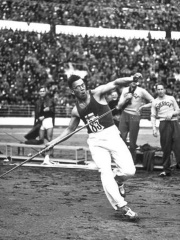
5. Matti Järvinen (1909 - 1985)
With an HPI of 63.62, Matti Järvinen is the 5th most famous Finnish Athlete. His biography has been translated into 31 different languages.
Matti Henrikki Järvinen (18 February 1909 – 22 July 1985) was a Finnish javelin thrower. He won the Olympic gold medal at the 1932 Summer Olympics ahead of two other Finns, Matti Sippala and Eino Penttilä, with a throw of 72.71 metres. Four of his other five throws would also have been enough to take gold. The three Finns did not take off their tracksuit trousers during the event. Besides his Olympic gold, Järvinen is remembered for his numerous world records. From 1930 to 1936, he broke the javelin throw world record a record ten times in a row. He also became the European champion in 1934, setting a new world record with 76.66 m, and defended his title successfully in 1938. In the 1936 Summer Olympics, Järvinen finished fifth. Järvinen continued throwing after World War II, recording a 71.70-metre throw in 1945. Järvinen was the son of Verner Järvinen, an Olympic bronze medalist in discus throw. His brother Akilles Järvinen was a decathlon world record holder and two-time Olympic silver medalist. His other brother Kalle was a shot putter and also an Olympian. The exact distance of his gold-winning throw, 72.71 metres, was used as the height of the Helsinki Olympic Stadium in commemoration of his achievement.

6. Albin Stenroos (1889 - 1971)
With an HPI of 61.87, Albin Stenroos is the 6th most famous Finnish Athlete. His biography has been translated into 24 different languages.
Oskar Albinus "Albin" Stenroos (24 February 1889 – 30 April 1971) was a Finnish runner, who won the marathon at the 1924 Olympics. Stenroos ran his first marathon in 1909, placing third at the national championships, but then moved to shorter distances, down to 1500 m. He would run his next marathon in 1924. In 1910, he won the 10,000 m race at the Finnish nationals. In the absence of Hannes Kolehmainen, Stenroos won the national titles over 5000 m and 10,000 m from 1912 to 1916 and the cross country title in 1915–1917. At the 1912 Summer Olympics, Stenroos won the bronze medal over 10,000 m behind Kolehmainen. He also finished sixth in the cross country and aided his team to second place. In 1915, he ran his first world record over 30 km (1:48:06.2), which he improved in 1924 (1:46:11.6). He also held the 20 km world record in 1923 (1:07:11.2). He skipped the 1920 Summer Olympics, but decided to run the marathon in 1924. He won the race in hot conditions, beating second-placed Romeo Bertini by almost six minutes. He placed second at the 1926 Boston Marathon and retired after failing to finish in 1927.

7. Ilmari Salminen (1902 - 1986)
With an HPI of 61.50, Ilmari Salminen is the 7th most famous Finnish Athlete. His biography has been translated into 28 different languages.
Ilmari R. Salminen (21 September 1902 – 5 January 1986) was a Finnish long-distance runner, winner of the 10,000 metres at the 1936 Summer Olympics. Salminen became one of the best long-distance runners in the 1930s when he began his international athletics career in 1934 by winning the 10,000 m and taking bronze in 5000 m at the first European Championships in Turin, thus becoming a main favorite at the Olympic 10,000 m run. On the first day of competitions in the Berlin Olympics, Salminen won the 10,000 m final before compatriots Arvo Askola and Volmari Iso-Hollo. Salminen managed to hold off Askola by a margin of 0.2 seconds. In the 5000 m final a few days later, Salminen finished in sixth place. In the next season, Salminen ran a new 10,000 m world record of 30:05.6. He also ran a new world record in six miles. Salminen finished his international career by winning the gold medal in 10,000 m at the 1938 European Championships and retired from athletics after the next season. He later became a sports official and headed the organizing committee of the 1952 Summer Olympics in Helsinki.

8. Volmari Iso-Hollo (1907 - 1969)
With an HPI of 60.95, Volmari Iso-Hollo is the 8th most famous Finnish Athlete. His biography has been translated into 25 different languages.
Volmari "Vomma" Fritijof Iso-Hollo (5 January 1907 – 23 June 1969) was a Finnish runner. He competed at the 1932 and 1936 Olympics in the 3000 m steeplechase and 10000 m and won two gold, one silver and one bronze medals. Iso-Hollo was one of the last "Flying Finns", who dominated distance running between the World Wars. As a youth, Iso-Hollo did skiing, gymnastics and boxing, and took up running when he joined the army. He was successful over distances between 400 m and marathon. Iso-Hollo won his first Olympic gold medal in the 3000 m steeplechase at the 1932 Summer Olympics. He was denied a chance at the world record because the officials lost count of the number of laps – the lap-counter was looking the wrong way, being absorbed in the decathlon pole vault. When Iso-Hollo went to his last lap, the official failed to ring the bell, and the entire field kept on running, covering the distance of 3460 m. If the distance were 3000 m, Iso-Hollo probably would have broken the world record. He also won the silver in the 10,000 m. In 1933, Iso-Hollo broke the 3000 m steeplechase world record, running 9.09.4 in Lahti and won the British AAA Championships title in the steeplechase event at the British 1933 AAA Championships. He went to the 1936 Summer Olympics as a favourite. He won the steeplechase by three seconds, finishing with a new world record of 9:03.8, and earned a bronze medal over the 10,000 m. After the Olympics, Iso-Hollo fell ill with rheumatism but kept on competing until 1945. He died in 1969 aged 62.

9. Gunnar Höckert (1910 - 1940)
With an HPI of 60.67, Gunnar Höckert is the 9th most famous Finnish Athlete. His biography has been translated into 25 different languages.
Gunnar Mikael Höckert (12 February 1910 – 11 February 1940) was a Finnish runner, winner of the 5000 m race at the 1936 Summer Olympics.
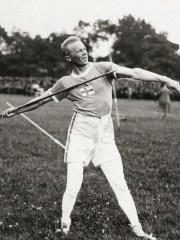
10. Jonni Myyrä (1892 - 1955)
With an HPI of 60.58, Jonni Myyrä is the 10th most famous Finnish Athlete. His biography has been translated into 23 different languages.
Joonas "Jonni" Myyrä (13 July 1892 – 22 January 1955) was a Finnish athlete who competed at the 1912, 1920 and 1924 Olympics. In 1912, he finished eighth in the javelin throw. At the 1920 Olympics, his left arm was fractured in a warm-up accident – the spear thrown by James Lincoln struck Myyrä while he was resting on the grass. Nevertheless, Myyrä won the javelin event with an Olympic record of 65.78 meters. He also finished 12th in the discus throw but could not complete his pentathlon events. Myyrä successfully defended his javelin title at the 1924 Summer Olympics and then fled to the United States due to his financial problems in Finland. He never returned to his home country and died in San Francisco in 1955. He threw one officially ratified world record in the javelin, 66.10 meters in Stockholm on 24 August 1919 and several other performances exceeding the official record at the time that were for various reasons not ratified, including his eventual personal best of 68.55 m achieved in San Francisco on 27 September 1925.
People
Pantheon has 168 people classified as Finnish athletes born between 1870 and 2003. Of these 168, 93 (55.36%) of them are still alive today. The most famous living Finnish athletes include Lasse Virén, Veikko Kankkonen, and Pertti Karppinen. The most famous deceased Finnish athletes include Paavo Nurmi, Hannes Kolehmainen, and Ville Ritola. As of April 2024, 15 new Finnish athletes have been added to Pantheon including Harri Eloranta, Ismo Falck, and Jyrki Järvi.
Living Finnish Athletes
Go to all RankingsLasse Virén
1949 - Present
HPI: 64.55
Veikko Kankkonen
1940 - Present
HPI: 57.97
Pertti Karppinen
1953 - Present
HPI: 56.38
Pekka Vasala
1948 - Present
HPI: 56.09
Kaarlo Kangasniemi
1941 - Present
HPI: 54.28
Päivi Meriluoto
1952 - Present
HPI: 54.22
Tiina Lillak
1961 - Present
HPI: 53.08
Juhani Suutarinen
1943 - Present
HPI: 52.76
Kaisa Mäkäräinen
1983 - Present
HPI: 51.49
Heikki Ikola
1947 - Present
HPI: 51.05
Kaarlo Maaninka
1953 - Present
HPI: 50.99
Arto Bryggare
1958 - Present
HPI: 50.69
Deceased Finnish Athletes
Go to all RankingsPaavo Nurmi
1897 - 1973
HPI: 75.77
Hannes Kolehmainen
1889 - 1966
HPI: 67.23
Ville Ritola
1896 - 1982
HPI: 64.51
Matti Järvinen
1909 - 1985
HPI: 63.62
Albin Stenroos
1889 - 1971
HPI: 61.87
Ilmari Salminen
1902 - 1986
HPI: 61.50
Volmari Iso-Hollo
1907 - 1969
HPI: 60.95
Gunnar Höckert
1910 - 1940
HPI: 60.67
Jonni Myyrä
1892 - 1955
HPI: 60.58
Lauri Virtanen
1904 - 1982
HPI: 60.37
Eero Lehtonen
1898 - 1959
HPI: 59.49
Elias Katz
1901 - 1947
HPI: 58.85
Newly Added Finnish Athletes (2025)
Go to all RankingsHarri Eloranta
1963 - Present
HPI: 45.59
Ismo Falck
1966 - Present
HPI: 44.44
Jyrki Järvi
1966 - Present
HPI: 44.39
Jari Lipponen
1972 - Present
HPI: 44.30
Ville Räikkönen
1972 - Present
HPI: 42.57
Paavo Puurunen
1973 - Present
HPI: 41.60
Wille Mäkelä
1974 - Present
HPI: 40.85
Päivi Alafrantti
1964 - Present
HPI: 40.35
Mikko Ronkainen
1978 - Present
HPI: 40.11
Mikaela Ingberg
1974 - Present
HPI: 39.88
Markku Koski
1981 - Present
HPI: 38.79
Minna Kauppi
1982 - Present
HPI: 36.99
Overlapping Lives
Which Athletes were alive at the same time? This visualization shows the lifespans of the 25 most globally memorable Athletes since 1700.

